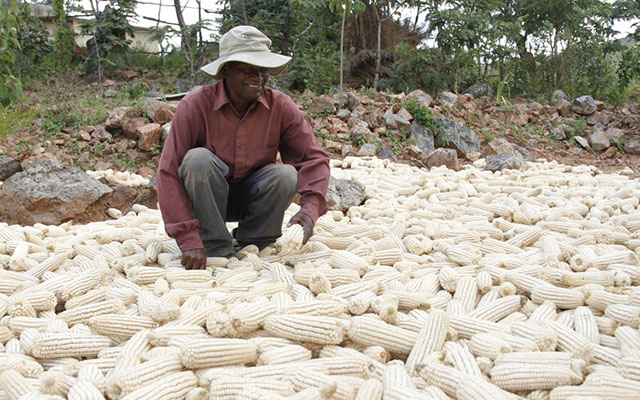West feeding off Ukraine more than Africa

Alexander Sokolov, Anna Kiseleva and Alexey Nikolskiy
Most vessels with Ukraine grain went to Western countries and NATO, receiving 57 percent of the goods, and only 17 percent went to Africa.
Among 88 ships with 2,08 million tonnes of grain, 65 went to the West and NATO between August 3 and September 4, Vedomosti calculated according to data from the UN and Marinetraffic.com published on Monday.
Exports there exceeded 1,18 million tonnes, or 57 percent of the shipped grain.
In 2021, Ukraine exported 12,6 million tonnes of cereals there, which accounted for 34 percent of grain exports, intended mainly for livestock feed.
The leader in the import of Ukrainian grain over the past month is Turkey, where 32 vessels with 0,37 million tonnes of cereals went.
Major importers also include Spain (6 ships and 0,82 million tonnes), Egypt (6 ships and 0,19 million tonnes), Italy (8 ships and 0,14 million tonnes) and South Korea (3 ships and 0,14 million tonnes).
The share of China, which usually dominated supplies earlier, has sharply decreased.
In 2021, it accounted for 11,4 million tonnes of exported Ukrainian grain, or 31 percent. And now three ships and 0,16 million tonnes of cereals (8 percent) have been sent there.
Over the past month, 10 ships and 17 percent of grain left for Africa from Ukraine, which roughly corresponds to the share of exports to the countries of the hungry continent in 2021 (18 percent).
However, the main share of supplies falls on Egypt, where famine is relatively not so strong (5 percent of the population suffers from it).
Representatives of Turkey, Ukraine, Russia and the UN agreed on the unblocking of Ukrainian ports in Istanbul on July 22. In total, they planned to take out 20-22 million tons before harvesting a new crop.
Prior to this, for several months, the West accused Russia of allegedly provoking increased famine in Africa and the Middle East due to the blocking of Ukrainian wheat in ports.
The EU warned in its report about the risk of a “catastrophic famine” due to the non-export of Ukrainian wheat. And the head of the UN World Food Programme, David Beasley, assured that 323 million people were threatened with hunger in connection with the situation in Ukraine.
What is exported
The very first ship, the Razoni, which sailed on August 3, initially headed for Lebanon with corn for chicken feed, but the grain was resold several times and eventually went to Syria, Reuters wrote.
It is fodder corn that prevails among the grain exported over the past month: 39 ships and 1,26 million tonnes.
It is mainly transported to Turkey and the EU. In addition, four ships took out sunflower meal and four – rapeseed, also mainly for livestock feed.
“Rich countries, under the guise of slogans about the fight against world hunger, solve their own problems, buying fodder crops for the future — primarily corn. But the main damage to the situation is not so much from the fact of buying corn, but from the fact that not food wheat,” says Eduard Zernin, chairman of the board of the Union of Grain Exporters.
“Ukraine has always mainly supplied fodder grain. It is still being transported to NATO countries, because it has always been transported to NATO countries.
In Europe, due to the drought this year, there will be problems with corn,” said the director of the Institute for Agricultural Market Studies (IKAR ) Dmitry Rylko.
The share of wheat, the shortage of which Western politicians spoke of, accounts for less than 19 percent of the shipped grain. So far, it has been taken out in the amount of 0,39 million tonnes on 20 dry cargo ships, nine of which sailed to Turkey, and four more to the EU.
This raises doubts that global food security depended on the grain deal to unblock Ukrainian ports, said Ivan Nechaev, deputy director of the information and press department of the Russian Foreign Ministry.
In total, 30 dry cargo ships and 0,77 million tonnes of Ukrainian grain (37 percent) went to Europe.
“No one expected that the EU would become one of the biggest beneficiaries of the ‘grain corridor’, pushing the countries that really need food into the background,” Zernin emphasises.
Against this background, the number of hungry people in Africa increased by 10 million in August, monitoring of the Union of Grain Exporters showed, according to the Food and Agriculture Organization (FAO) of the UN.
Help for the starving
The first ship specifically to the countries with the most acute problem of hunger left only on August 21. Bulk carrier Brave Commander sent 23 300 tonnes of wheat to Djibouti for Ethiopia.
By that time, for almost two weeks, even Western publications were indignant about why the long-awaited grain was not being delivered to the starving countries.
“The market is not always able to send grain to where it is needed,” lamented New York Times journalist Ruth McLean.
Vessels do not go to starving countries because of the typical market balance of supply and demand, says Andrey Sizov, director of the Sovecon analytical centre.
The arguments of Western politicians that these products must have gone to the starving countries of Africa were absolutely groundless — they were sent to where they are offered the best price, as is usually done, the expert is sure.
So far, only five ships with 0,17 million tonnes of wheat (44 percent of all wheat and 8 percent of all cereals exported from Ukraine in a month) have been sent to the supplying countries, where more than 10 percent of the population suffers from this disaster.
In addition to Djibouti, it is also Lebanon, Somalia, Yemen and Sudan.
The situation with hunger is really catastrophic in many African countries.
Most of the undernourished are in the Congo (36 million people), Ethiopia, Tanzania, Kenya, and in terms of the share of the hungry among the population – in Somalia (60 percent), the Central African Republic, Madagascar, Congo.
In the world by 2021, 828 million people suffered from hunger, according to an FAO estimate, which is 46 million people more than a year earlier.
“The high cost of healthy diets, coupled with persistently high levels of poverty and income inequality, continues to put such diets out of reach for about 3 billion people in all regions of the world,” says the latest FAO report.
The word “inequality” is mentioned by the authors of the report more than 150 times, which speaks eloquently about the origins of hunger in the world.
Grain shortage in the world was exacerbated by natural disasters, as a result of which most traditional grain exporters not only closed exports, but also entered the world market with purchases, Zernin notes: “Russia, harvesting a record wheat harvest, could act as a compensating supplier,” he continues.
“Moreover, if in the structure of Ukraine’s grain exports mainly fodder prevailed, then Russia has just wheat – it accounts for about 80 percent of cereal exports, follows from UN Comtrade data”.
The grain harvest by the end of this year could reach 130 million tonnes, Russian President Vladimir Putin noted.
Of these, wheat — a record 87 million tonnes, the Ministry of Agriculture predicted.
In the second half of the year, Russia would be ready to supply up to 30 million tonnes of grain to foreign markets as part of its obligations to international partners, Interfax reported citing the ministry.
“But Western sanctions, fleet shortages and billing problems have severely limited Russia’s export options,” Zernin says.
A number of terminals are connected with the state, in particular, they have state owners who are under sanctions, one of the senior leaders of the grain industry noted in an interview with Vedomosti.
And besides the problems with ships entering Russian ports, the banks of a number of countries importing our grain, mainly from developing countries, do not want to issue letters of credit for its delivery, Rylko noted: “They eschew Russian origin and the possibility of imposing sanctions.”
As a result, wheat exports in July and August decreased by 22 percent compared to last year and amounted to 6,3 million tonnes, Bloomberg wrote.
So far, Russia is solving the problem of ensuring the food security of traditional partners from the MENA countries (a region that unites the countries of the Maghreb and the Middle East).
“In order for Russian wheat to become available to all those in need, it is necessary to remove all unspoken restrictions as soon as possible,” Zernin sums up. — Vedomosti newspaper







Comments